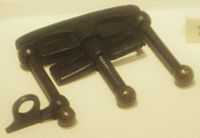Thumbscrew (torture)




The Thumbscrew or pillywinks is a torture instrument which was first used in medieval Europe. It is a simple vice, sometimes with protruding studs on the interior surfaces. The victim's thumbs or fingers were placed in the vice and slowly crushed. The thumbscrew was also applied to crush prisoners' big toes. The crushing bars were sometimes lined with sharp metal points to puncture the thumbs and inflict greater pain in the nail beds. Larger, heavier devices based on the same design principle were applied to crush feet and ears.
History
As late as the mid-18th century, the ex-slave Olaudah Equiano, in his autobiography The Interesting Narrative of the Life of Olaudah Equiano documented the use of thumbscrews to torture slaves.[1] During this period (mid-18th century) Thomas Clarkson carried thumbscrews with him to further his cause for the abolition of the Slave Trade, and later emancipation of slaves in the British Empire. He hoped to and did inspire empathy with the display of this and other torture devices used on slaves.[2] This form of torture was also used to exact confessions due to the excruciating pain it caused. In medieval and Renaissance England, the thumbscrew was also utilized in a way that would straighten girls fingers to make them look more elegant and elongated. It is recorded that there is a possibility that the nursemaid of Elizabeth I used this device on Elizabeth to create her elegant fingers.They were widely used on slave ships, as backed up by Thomas Clarkson and Olaudah Equiano [3]
References
- ↑ Equiano, Olaudah (1789). The Interesting Narrative of the Life of Olaudah Equiano, Or Gustavus Vassa, The African. "The iron muzzle, thumb-screws, &c. are so well known, as not to need a description, and were sometimes applied for the slightest faults."
- ↑ Hochschild, Adam. "Bury the Chains, The British Struggle to Abolish Slavery" (Basingstoke: Pan Macmillan, 2005)
- ↑ "Extensive Definition". AskDefine. Retrieved 23 December 2012.
External links
| Wikimedia Commons has media related to Thumbscrews. |